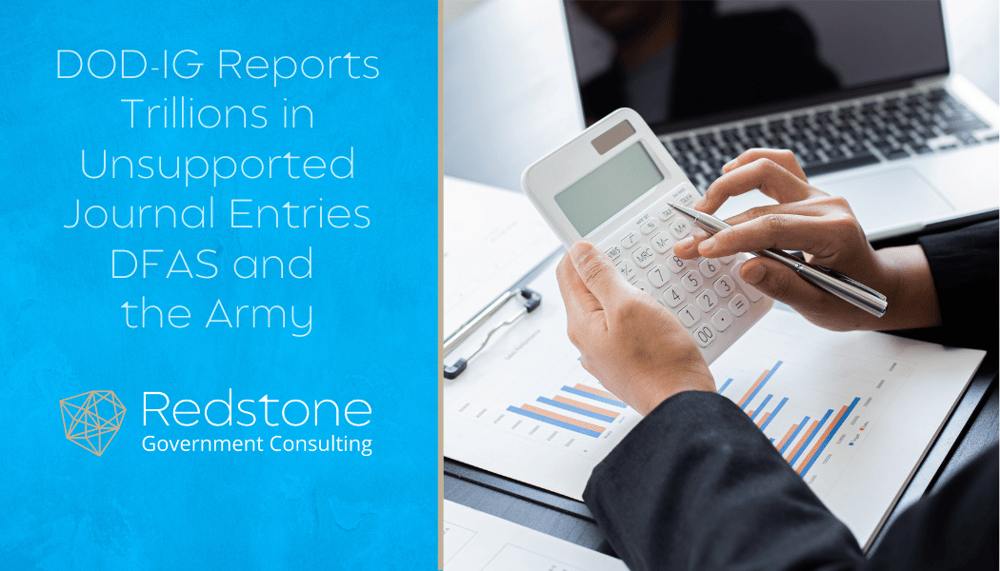
In a report issued on July 26, 2016, the DOD- IG (Department of Defense Inspector General) concluded that DFAS (Defense Finance and Accounting Service) and the Department of the Army (Army General Fund or AGF) failed to support $4.44 Trillion in JV (Journal Voucher) Adjustments.
The following table (page 6 of the report DOD IG 2016-113) provides a snapshot of the unsupported amounts in relation to supported and total amounts for Journal Vouchers:
|
Quarter |
Unsupported |
Supported |
Total |
|||
|
FY2015 |
Count |
$ Trillions |
Count |
$ Trillions |
Count |
$ Trillions |
|
Third |
60,706 |
$0.88 |
3,615 |
$2.29 |
64,321 |
$3.17 |
|
Yearend |
138,887 |
$4.44 |
3,468 |
$2.43 |
142,335 |
$6.87 |
Although the actual impact of the unsupported JVs is not reported (rarely do IG reports determine if there are actual misstatements, only that there is a risk of misstating financial data for the AGF), it would seem rather alarming that $4.44 trillion is unsupported, especially when compared to the supported amount of $2.43. Not exactly an immaterial issue in relative or absolute terms, and as reported by the DOD-IG, the end result is “Data Unreliable and Audit Readiness at Risk” (the latter reference is to the congressionally mandated requirement for audit readiness, or auditable financial statements, by September 30, 2017).
In addition to DOD-IG Report 2016-113, there was an earlier IG report, DODIG-2016-086, which concluded that DOD met five of six requirements of the Improper Payments and Elimination and Recovery Act of 2015. The one requirement which failed was (for the fourth consecutive year) a reduction target for the DOD Travel Pay program. Per the DFAS website, the agency annually disburses $579 billion and processes 6 million travel vouchers; hence, DOD’s failure to achieve target reductions for its Travel Pay program is the responsibility of DFAS.
Some interesting facts reported by the DOD-IG and gleaned from the DFAS website:
- The GAO (Government Accountability Office) identified unsupported adjustments (Journal Vouchers) as a material weakness in AGF internal controls in its 1991 In FY2008 (17 years later), the Army indicated (or was still indicating) that this material weakness would be corrected, in this case by the end of FY 2011 (apparently requiring 20 years to promise to correct a material internal control weakness). Not surprisingly, in its July 2016 report, the DOD-IG concluded that the Army and DFAS did not prioritize correcting the system deficiencies.
- The DOD-IG also reported that DFAS could not explain why they (DFAS) removed over 16,000 feeder files during the third quarter import process, stating, “without support for why these records were removed, we could not determine whether the records contained valid transactions that should have been reported in the AGF.”
is this a comment from the editor of the DOD-IG report or this editor? No parentheses are necessary if it is THIS editor (Editor comment: Perhaps these will be located at the same time Russia locates the 30,000 emails missing from a previous Secretary of State’s private email server). - In responding to the DOD-IG 2016-113 report, DFAS insisted that the counts were inaccurate and/or duplicative; the DOD-IG dismissed this fact based upon its detailed explanation supporting the DOD-IG counts. (Editor comment: One would expect that the auditee might address the substance of the issue(s), rather than argue record or dollar count).
- In 2013, the DFAS Director took actions to insource functions being performed by approximately 2,100 contractor employees.
- In 2016, the DFAS Director received the Distinguished Presidential Rank Award. One must note that the Director also received the Meritorious Presidential Rank Award in 2006, as did the DFAS Deputy Director in 2009. The Distinguished Rank Award is presented to leaders who achieve sustained extraordinary accomplishments while the Meritorious Award is for sustained accomplishments. (Editor comment: An Agency Director might not know of every issue which shows up in an IG report; however, the long-standing issue of unsupported journal vouchers in the trillions of dollars should be “on the radar”).
- In terms of relative dollar amounts, the total amount of Army General Fund journal vouchers was $6.87 trillion; it is notable that the entire US budget for FY 2016 is $4 trillion.
- In its 2015 Fraud Guidance, the DOD-IG lists the following as general fraud indicators:
- Lost or destroyed electronic or hard-copy records
- Excessive numbers of journal vouchers/adjusting entries
(Editor comment: These indicators only apply to government contractors who are presumed to have financial incentives, unlike internal government operations where fraud indicators are (apparently) assumed to be unintentional).
As with far too many GAO or IG reports, the issues seem to go unresolved with little or no negative implications to the government agency(ies) or the agency management (unless one or more members of the Legislative Branch take an interest in the issue, in which case there will be scapegoats). Vastly different in application to government contractors where inconsequential business systems issues can lead to payment withholds (DFARS 252.242-7005) and in the case of “too many adjusting journal vouchers”, referral to an investigative agency (reference to the DOD-IG Fraud Awareness Handbook). At any rate, for anyone trying to win the contest for the highest dollar value for adjusting journal entries, the Department of the Army has set the bar high at $6.87 trillion.


 Mike Steen is a Emeritus Advisor with Redstone Government Consulting, Inc. and a specialist in complex compliance issues to include major contractor cost accounting & business system regulations, financial compliance, resolution of DCAA audit issues, Cost Accounting Standards application, litigation support, and claims preparation. Prior to joining Redstone Government Consulting, Mike served in a number of capacities with DCAA for over thirty years, and upon his retirement, he was one of the top seven senior executives with DCAA. Mike Served as a Regional Director for two DCAA regions, and during that time was responsible for audits of approximately $25B and 800 employees. In October 2001, he was selected for the Senior Executive Service and in 2006 he received the Presidential Rank Award. During Mike’s tenure with DCAA, he was involved in conducting or managing a variety of compliance audits, to include cost proposals, billing systems, Cost Accounting Standards, claims, defective pricing, and then-evolving programs such as restructuring, financial capability and agreed-upon procedures. He directly supported the government litigation team on significant contract disputes and has prepared and presented various lectures and seminars to DCAA staff and business community leaders. Since joining Redstone Government Consulting in June 2007, Mike has developed and presented training and seminars on Government Contracts Compliance to NCMA, Federal Publications Seminars and various clients. Mike also is a prolific contributor of written articles to government contracting publications, as well as to our own Government Insights Newsletter. Mike also serves as the director of our training service offerings, with responsibilities for preparing and developing course content as well as instructing our seminars to clients and general audiences throughout the U.S. Mike also serves as a faculty instructor for the Federal Publications Seminars organization. Education Mike has a BS Degree in Business Administration from Wichita State University. He is also a graduate of the DCAA Director’s Fellowship Program in Management, and has a Masters Degree in Administration from Central Michigan University. Mr. Steen also completed a number of OPM’s management and executive development courses.
Mike Steen is a Emeritus Advisor with Redstone Government Consulting, Inc. and a specialist in complex compliance issues to include major contractor cost accounting & business system regulations, financial compliance, resolution of DCAA audit issues, Cost Accounting Standards application, litigation support, and claims preparation. Prior to joining Redstone Government Consulting, Mike served in a number of capacities with DCAA for over thirty years, and upon his retirement, he was one of the top seven senior executives with DCAA. Mike Served as a Regional Director for two DCAA regions, and during that time was responsible for audits of approximately $25B and 800 employees. In October 2001, he was selected for the Senior Executive Service and in 2006 he received the Presidential Rank Award. During Mike’s tenure with DCAA, he was involved in conducting or managing a variety of compliance audits, to include cost proposals, billing systems, Cost Accounting Standards, claims, defective pricing, and then-evolving programs such as restructuring, financial capability and agreed-upon procedures. He directly supported the government litigation team on significant contract disputes and has prepared and presented various lectures and seminars to DCAA staff and business community leaders. Since joining Redstone Government Consulting in June 2007, Mike has developed and presented training and seminars on Government Contracts Compliance to NCMA, Federal Publications Seminars and various clients. Mike also is a prolific contributor of written articles to government contracting publications, as well as to our own Government Insights Newsletter. Mike also serves as the director of our training service offerings, with responsibilities for preparing and developing course content as well as instructing our seminars to clients and general audiences throughout the U.S. Mike also serves as a faculty instructor for the Federal Publications Seminars organization. Education Mike has a BS Degree in Business Administration from Wichita State University. He is also a graduate of the DCAA Director’s Fellowship Program in Management, and has a Masters Degree in Administration from Central Michigan University. Mr. Steen also completed a number of OPM’s management and executive development courses.